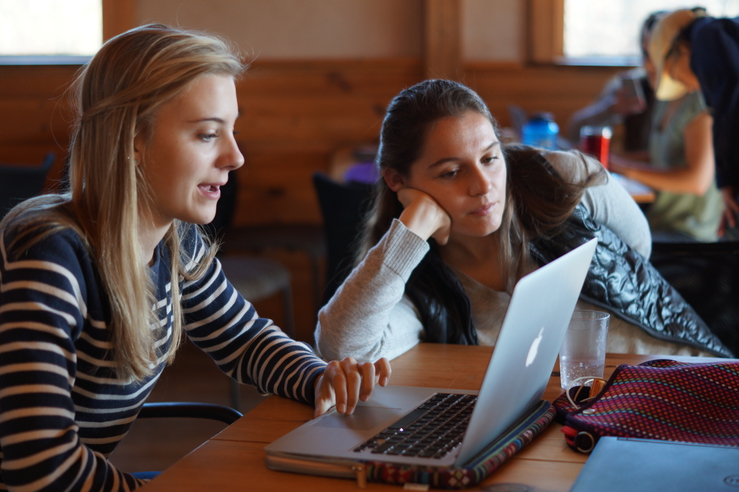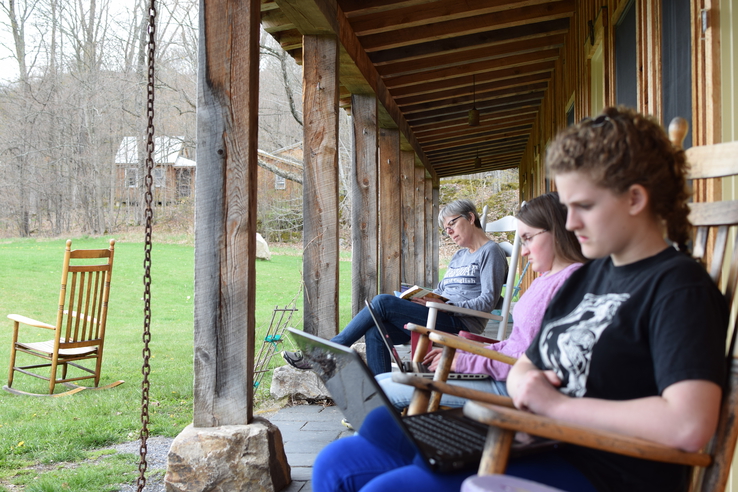
Broken Mics and Other Learning Experiences
While setting up for my first interview, I spent about ten minutes detangling the cord for the clip on mic, tested it, and found that it didn’t work. I then scrambled to pack it away and set up the shotgun mic, which didn’t give us the sound quality we wanted, but at least was functioning. Setting up for my next interview, I found that somewhere along the way, part of the mic had come off, and it now could not be attached to the tripod stand. Again, I scrambled for a solution while another very patient interviewee waited. I ended up borrowing scotch tape and securing it the best I could, lopsided and wobbly, but again, at least functional.
Our mic troubles illustrate one of the biggest takeaways I have from this class, which is that things go wrong often, and when they do, you just have to do the best you can with what you have. Whether it was technical issues with the the equipment, or trouble uploading footage, or difficulty organizing ourselves in three different towns across the state, this course time and time again made us problem solve and compromise to get what we needed done. In a typical class, contained in a single classroom at one time of day, the risk of something going wrong is much lower. Worse case scenario, you turn in an essay a day late because of technical issues, or a miscommunication means your group project isn’t ready for presentation. For us, a miscommunication meant someone didn’t have the camera they needed, and a technical failure could mean the interview we recorded had no sound and was useless. This lack of a safety net pushed me to be more organized, communicate better with my group, and learn how to handle mishaps. As a result, I’ve learned how to plan ahead, and then how to come up with a plan B when the unexpected happens.
The self-directed format of this class was not always very comfortable for me. I’m used to traditionally structured classes where I don’t have to decide what to learn or what to do with what I’ve learned. Having to decide what matters and what doesn’t for our project, and assembling a documentary that effectively got across our idea while juggling the nitty gritty issues of scheduling and filming footage, was way out of my comfort zone. It meant I had to take the work seriously, and engage with it on a deeper level than one does in a traditional classroom (not that I don’t work hard in class, just that it is much easier to get away with slacking off in that setting). Pulling it all together meant working on the smaller details while still having an idea of the bigger picture. As a result, I have gotten much better about seeing the bigger picture and the end goal, and focusing less on what goes wrong or right in the moment. Mics break all the time, you just have to fix it and move on to the next problem.
Self Direction:
Going into WTS, I knew it was going to be more self-guided than other courses I had undertaken, but I didn’t fully grasp what that meant until a while into the course. The beginning felt fairly familiar, investigating topics of our own, with guidance and some framework. Once we divided into groups and began work on our documentaries, it became clear to me that this course requires students to take responsibility for their own learning experience in a way I was neither familiar nor necessarily comfortable with. In making the documentary, we had to decide which angle to take on the issue, who to interview, and how we wanted our video to reach an audience. This required a great deal of planning and coordination, as we were working from Middlebury to Shelburne to St. Albans and interviewing people everywhere in between. Initially, I struggled to set aside time from my regular, more structured schoolwork to work on the project, and I think that was reflected in the work I did at the time. However, as the year progressed and I had more time to consider the subject and adjust to the work we needed to do, I think I became much more engaged in my own learning process and really took responsibility for it. I had started the year caring about our topic, but by the end, I was able to put that energy into productivity, and ultimately I was very proud of what our group accomplished in this course.
Responsible and Involved Citizenship:
My initial viewpoint on this issue was black and white, mostly because I didn’t know very much about it. My idea was more or less: the confederate flag represented the upholding of slavery, slavery was bad, therefore the confederate flag represents a bad thing. I still think that’s pretty much true, but with the work I’ve done this year, my understanding of the issue has become far more complex. We chose to look at our topic from multiple angles: the historical context of the flag, the legal precedent for restricting hateful images in schools, the decision making process for school administrators who had banned the flag, and the accounts of students for whom the confederate flag was a hurtful or distressing part of their school experience. I’m glad we chose to approach the documentary in this way, because I think it made for a much more balanced message, and it allowed me to understand the interconnectedness of all these topics. By the end of the year, I had a more nuanced understanding of the issue, and I could more effectively make the argument we set out to make at the beginning of the year because I understood what we were working towards and what it really meant in our society on a deeper level than I had when we began.
Informed and Integrative Thinking:
A big challenge we faced early on in our process was that the Confederate Flag, like any social issue, does not have a single definition or historical context. Its original use in the Civil War is significant to its usage today, but so is its repurposing in the 20th and 21st centuries by the KKK, people protesting civil rights, and the Alt Right. Banning it in schools requires examining the legal and ethical questions of students’ rights and the line between hate speech and free speech. Ultimately, of course, we must consider the actual impact the display of the flag has on the school environment. Presenting all of this in one short documentary without minimizing any of it was a pretty daunting process. Having a year long course to work on it gave me the time I needed to fully investigate the topic from each angle, and understand how these issues all relate. In the end I believe we had a stronger thesis statement and a more persuasive argument for it because we could discuss the Confederate Flag in its entirety and address the whole of its implications in today’s society.
Clear and Effective Communication:
When it comes to issues I care about, I often find that I do a poor job of communicating just why I feel strongly about them. Seeing as the main point of this course is communicating an idea we feel strongly about, I’ve had to improve as a communicator over the last year. I’ve realized it requires a great deal of empathy and self-awareness. While I may intend for my message to have a certain effect, I cannot control how others respond to it. Originally we meant for our audience to be school administrators in the hopes of convincing them that the Confederate flag should be banned in public schools, but over time we realized that we would have a greater impact if we focused on the wider school communities with the hope of sparking a conversation over the flag that could effect change. I had to consider not just my ideas and how I wanted change to happen, but how others would feel about them and what other people valued. As a result, our final documentary more effectively communicated our core ideas in a way that (hopefully) others will appreciate.
Photo by Anjana Menon on Unsplash
 Previous Post
Previous Post Next Post
Next Post






